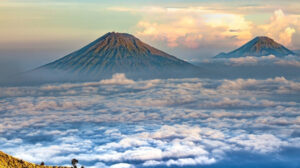The Cascade Range in western North America stretches from southern British Columbia through Washington and Oregon to northern California, and throughout the region are both non-volcanic mountains and volcanoes known as the High Cascades, many of which have remained dormant for many years.
Now, new research conducted by the Department of Earth and Atmospheric Sciences at Cornell University in New York reveals that even beneath volcanoes thought to be dormant, large amounts of magma lie, with potentially huge implications for the way geologists predict and observe volcanic eruptions.
It may have until recently been the prevailing view that only underneath active volcanoes were large amounts of magma, which when they erupt mass is released and dissolved, but the report published in Nature Geoscience offers a new reading.
Regarding the volcanoes in the Cascade Range, some have been inactive for about 4,800 years, while seven erupted in the early 18th century. The research team found that all of the volcanoes studied had large volumes of magma underneath them, including those that were considered inactive.
“Regardless of the frequency of eruptions, we see large volumes of magma under many volcanoes. It seems to exist underneath them throughout their lifetime, not just during an active state,” said researcher and study leader Guaning Pang.
“Despite the diversity, we find crustal magma bodies of comparable sizes under all these volcanoes at similar depths,” the study said, with the researchers arguing that the volcano’s eruption ultimately does not drain the magma chambers, but merely relieves the pressure.
While this assessment potentially complicates the picture of volcanic activity, it could help geologists make better predictions about volcanic eruptions.
“We used to think that if we found a large amount of magma, that meant an increased likelihood of an eruption,” Pang added, “but now that perception is changing.”
For his part, Professor of Geological Sciences, Geoffrey Ambers, explained that further research is needed, as this would allow a better understanding of how volcanoes work, at a time when many of them are either not monitored often or have not undergone intensive study.
For this reason, the next goal of researchers is to research volcanoes in Alaska and other regions.
Ask me anything
Explore related questions





